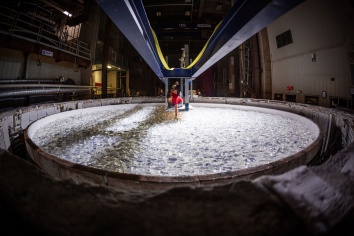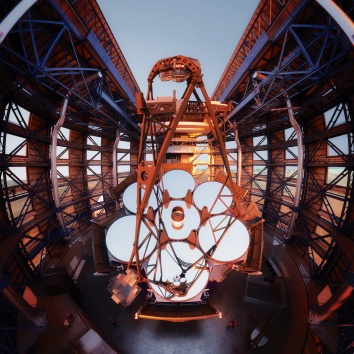AUSTIN, Texas - The University of Texas at Austin’s McDonald Observatory and other Giant Magellan Telescope partners today shared in announcing the casting of the final primary mirror for the world’s largest telescope. The Giant Magellan Telescope begins the four-year process to fabricate and polish its seventh mirror, the last required to complete the telescope’s 386-square-meter (1,266-square-foot) light collecting surface, the world’s largest and most challenging optics ever produced. Together, the mirrors will collect more light than any other telescope in existence, allowing humanity to unlock the secrets of the Universe by providing detailed chemical analyses of celestial objects and their origin.
Last week, the University of Arizona Richard F. Caris Mirror Lab closed the lid on nearly 20 tons of the purest optical glass inside a one-of-a-kind oven housed beneath the stands of the Arizona Wildcats Football Stadium. The oven will heat the glass to 1,165°C (2,129°F) while spinning, so as it melts the glass is forced outward to form the mirror’s curved paraboloid surface. Measuring 8.4 meters (27.6 feet) in diameter—about two stories tall when standing on edge—the mirror will cool over the next three months before moving into the polishing stage.
At 50 million times more powerful than the human eye, “the telescope will make history through its future discoveries,” shares Buell Jannuzi, principal investigator for the fabrication of the Giant Magellan Telescope primary mirror segments, director of Steward Observatory, and head of the Department of Astronomy at the University of Arizona. “We are thrilled to be closing in on another milestone in the fabrication of the Giant Magellan Telescope.”
The most recently completed primary mirror is ready for integration into a giant support system prototype early next year for final optical performance testing. This testing will serve as the dress rehearsal for all seven primary mirrors. Once assembled, all seven mirrors will work in concert as one monolithic 25.4-meter (83.3-foot) mirror—a diameter equal to the length of a full-grown blue whale—resulting in up to 200 times the sensitivity and four times the image resolution of today’s most advanced space telescopes.
The Giant Magellan Telescope will be the first extremely large telescope to complete its primary mirror array. With strong operational infrastructure completed at the telescope site in Chile, focused manufacturing is taking place on the telescope’s critical subsystem before starting on the enclosure.
“The telescope is a monumental achievement in not only scientific study but also international collaboration,” shares Taft Armandroff, director of The University of Texas at Austin’s McDonald Observatory, a founding partner of the Giant Magellan Telescope. “Its design, construction, operation, and funding are made possible by a consortium of top universities in the US and partners worldwide.” Parts and instruments made across the globe will come together in the Atacama Desert of Chile for final assembly.
“We are in an important stage of fabrication, with much of the manufacturing happening in the United States,” shares Robert Shelton, president of the Giant Magellan Telescope. The 39-meter (128-foot) tall telescope structure is being manufactured with 2,100 tons of American steel at a newly built manufacturing facility in Rockford, Illinois, and fabrication of the telescope’s first of seven adaptive secondary mirrors—a one for one pair with each of the seven primary mirrors—is underway.
When complete, the Giant Magellan Telescope will be the most powerful telescope on Earth. “The combination of light-gathering power, efficiency, and image resolution will enable us to make new discoveries across all fields of astronomy,” shares Rebecca Bernstein, chief scientist for the Giant Magellan Telescope. “We will have a unique combination of capabilities for studying planets at high spatial and spectral resolution, both of which are key to determining if a planet has a rocky composition like our Earth, if it contains liquid water, and if its atmosphere contains the right combination of molecules to indicate the presence of life.”
The telescope is expected to see first light by the end of the decade, and will equip Texas astronomers with amazing tools to answer some of humanity’s most pressing questions: Where did we come from? Are we alone in the Universe?
The Giant Magellan Telescope is made possible by a consortium of universities and science institutions. Members include Arizona State University, Astronomy Australia Limited, Australian National University, Carnegie Institution for Science, the São Paulo Research Foundation (FAPESP), Harvard University, Korea Astronomy and Space Science Institute (KASI), Smithsonian Institution, Texas A&M University, The University of Texas at Austin, University of Arizona, University of Chicago, and Weizmann Institute of Science.
Based on a press release by the Giant Magellan Telescope.
- END -
Media Contacts
Ryan Kallabis
Director of Communications & Outreach
Giant Magellan Telescope
rkallabis@gmto.org
626-204-0554
Emily Howard
Communications Manager
The University of Texas at Austin McDonald Observatory
emily.howard@austin.utexas.edu
512-475-6763








